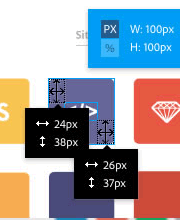
If you’re reading this post, then you’re probably trying to sell something online.
Whether you run a SaaS business, or you’re a freelancer selling your services, you can always use a few more sales or leads. Regardless of your business, it’s going to be powered by killer copywriting.
But, improving your conversions seems so difficult and you don’t have the budget to hire a high-end copywriter.
Copywriting is a hard-won skill. But, that doesn’t mean you can’t use some of its tools for your own business.
Below you’ll find 7 copywriting tricks of the trade that’ll help to boost your conversions.
1. Repeat, and Repeat Again
The more often we hear something the more likely we are to believe it’s true, regardless of whether it’s actually true or not.
Think about it — how many beliefs do you have hard-wired into your brain, just because your parents would say them incessantly when you were young?
What does that mean?
It means the more often you repeat yourself, the more likely your readers are going to believe you. Now, that doesn’t mean you can just copy and paste lines of previously written copy. You do need to be a little more subtle than that.
The goal is to find the phrases within your existing copy you’d like your readers to remember the most and repeat them as often as possible.
2. Steal (Ethically, of Course)
I’m not giving you permission to steal your competitor’s copy. I’m talking about a different kind of theft.
It’s about stealing the language of your market.
What a better way to make your readers feel like home, than to use the same language that’s floating around their own heads.
You know that whole “you read my mind” type of feeling? The only way to extract these juicy tidbits of your ideal market’s language is to study them.
Chances are you’re already familiar with your target market. If you don’t feel like you know them intimately, then it’s time to stalk them. Visit Facebook groups where they hang out, check out relevant forums, read the comment sections of the blogs you know they read, look in the review sections of Kindle books they read.
Make special note of the words and phrases they use, and infuse them into your existing copy.
Don’t waste time playing the guessing game of what words you should use. Your market is telling you what they want and what magic phrases you can use to help them open their wallets.
3. Justify Yourself
There’s a great book on persuasion called Influence by Robert Cialdini. If you have time to add another book to your reading list, I’d highly recommend checking it out.
But, here’s the main point.
It highlights a study done way back in 1978 (yes, the world did exist before the Internet). It focused on using the word ‘because’ to justify your actions.
In the experiment people who were waiting in line were asked a question in three different ways:
- “Excuse me, I have five pages. May I use the Xerox machine, because I’m in a rush?”
- “Excuse me, I have five pages. May I use the Xerox machine?”
- “Excuse me, I have five pages. May I use the Xerox machine, because I have to make copies?”
Which one do you think performed the worst? Number 3, right?
Wrong!
It was number 2. The reason. It lacked the simple word ‘because’.
Researchers believe this is due to our “click-whirr” programming, which has us rely upon learned behavior when making decisions.
What’s the lesson?
Use the word ‘because’ whenever you’re making a claim about your product, or yourself, or requesting your users to take any action.
4. Let Your Reader Say No
Readers don’t like being held hostage.
Instead of your copy gripping the throat of your readers, holding them hostage to your page. We still want them to feel the same pull to our page, but with a little less violence.
When making a request from your reader make sure to remind them that they’re free to say no, or leave at any time.
Give your users the power of choice and you’ll see them choosing you, more often than not.
For instance, are you trying to get users to sign up for a free trial of your software?
Then, trying something like this: “Enter your email below to grab our free resource ‘137 Ways to Keep Your Goldfish Alive’. If you hate it, you can unsubscribe at any time. We won’t be mad.”
5. Showcase Your Faults
People want to know who they’re buying from. This is especially true if you’re selling your services. Beyond what you can do for the company thinking about working with you, you’re also selling yourself.
It’s kind of a package deal.
I get it. It’s scary to be vulnerable. To admit your weaknesses. To show that you’re not the right fit for everyone. But, you know that old quote that says, “a good brand repels just as much as it attracts.” It’s true.
Be the first to admit the things that your product doesn’t do.
Take a stand for your small army of buyers.
You’re not the perfect fit for everyone.
You’ve made mistakes and in showing these you become more human.
Don’t be afraid to disqualify yourself and people who aren’t the right fit for you.
For example, think about a phrase like, “if you’re looking for a app developer who can guarantee your app will hit the top of the Apple charts, then I’m not your guy. I’ll work my tail off to produce an app that will delight your users and is positioned to succeed. But, we don’t make impossible promises. And, here’s what we can guarantee…”
How much more relatable and authentic does that seem?
This also connects with the idea that we as humans have built in bullshit detectors. Even two-year olds know when we’re lying. Be honest. Make promises you can keep and show your human side.
We like to do business with humans. We’re not robots, yet.
6. Use Open Loops
Why is Netflix so addicting?
Why can’t you put down that juicy YA novel, even though it’s 2am and you have work in the morning?
What do these questions have to do with your copy?
Everything. Well, kind of. Let me explain.
When you’re hours deep into a Netflix binge, or absolutely addicted to that new novel, there’s a reason for it and it has to do with open loops.
Right before an episode or chapter ends a new story thread is opened. These openings are a new question that we need the answer to. Unanswered questions just don’t feel good.
How can you utilize the addictive power of open loops in your copy?
It’s simple. Ask questions, or make statements, that you don’t automatically give the answers to. In order to get the answer, and close the loop, they have to take the action you want them to take.
For example, let’s say you’re selling invoicing software for stressed out online business owners.
Instead of simply saying, “take the hassle out of invoicing with our software”, you could say something like “what do successful entrepreneurs know about invoicing that you don’t?” Then, to find out the answer, they have to join your email list.
7. Invoke Their Imagination
The imagination of your reader is a powerful ally. Sadly, most website copy is boring. You’ll need a gallon of coffee to prevent you from dozing off again. Your website doesn’t have to succumb to this familiar fate.
How can you avoid the pain of a low-converting, drowsiness-inducing, sales page?
By making them imagine their life, with the benefits your product or service brings.
For example, let’s say your app helps entrepreneurs outsource small tasks to free up an hour or two of extra time each day.
Instead of talking about the qualifications of your team, or the features of your software, we’ll take a different approach and get them thinking about what their life will be life while working with you with questions like this:
- What will you do with an extra two-hours of free-time each day?
- What would your life look like if you had 26 hours in a day?
- Imagine…having an extra two-hours of focused work every single day? What would your business look like?
- Imagine never feeling stressed for time, ever again.
Now, those are just examples, but they get your mind thinking about their life with your product. That’s much more enticing than a list of the technical elements of your app.
Unlock the potential of your probably boring copy with the tips above. I dare you.
Any copywriting boosters I forgot to mention above? Share your favorites in the comments below.
 Kevin Wood
Kevin WoodKevin Wood is a freelance tech blogger, who thrives on writing meaningful content for online businesses, he writes at Wooden Writing.








